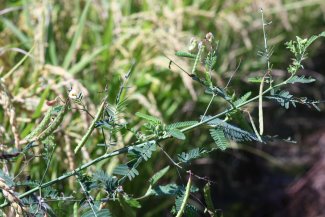South America
Northern America
Northern Mexico: Mexico - Durango, - Sonora, - Tamaulipas
Southern Mexico: Mexico - Campeche, - Chiapas, - Jalisco, - Michoacan, - Nayarit, - Oaxaca, - Tabasco, - Veracruz, - Yucatan
Southern America
Brazil: Brazil - Rio Grande do Sul
Caribbean: Cuba; Puerto Rico
Mesoamerica: Belize; Costa Rica; Nicaragua; Panama
Northern South America: Guyana; Venezuela
Southern South America: Argentina - Buenos Aires, - Chaco, - Entre Rios, - Formosa, - Misiones, - Santa Fe; Paraguay - Amambay, - Central, - Alto Paraguay, - Presidente Hayes, - San Pedro; Uruguay - Soriano
Western South America: Bolivia; Colombia; Ecuador
Typically perennial, but acts as an annual herb with taproot in California. It is aquatic or semi-aquatic, growing bristly, glandular stems near or in water. It grows up to two metres tall. The leaves are composed of oval-shaped leaflets each about a centimetre long. At the base of each leaf are large, flat, pointed stipules. The flower is purple-tinted white and 1 to 1.5 centimetres wide. The fruit is a lobed, gland-dotted legume pod narrowed between the seeds. It is up to 5 centimetres long and less than one wide. As the pod dries it breaks into segments, each segment containing a seed. The hard, shiny seed is kidney-shaped and 2 or 3 millimetres long. California Pest Rating Aeschynomene spp., jointvetch Rosidae; Fabales; Fabaceae Pest Rating: A | Seed Rating: P Initiating Event: A. rudis has been rated as “A” on the CDFA Plant Pest Rating List after being detected in a rice field in California. In California, this plant is known only from a rice field in Colusa County.
